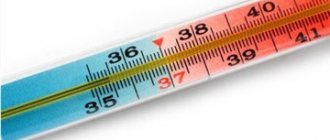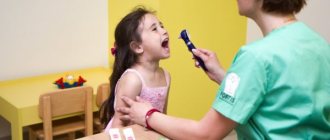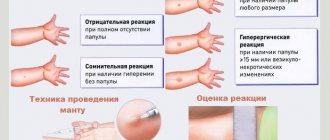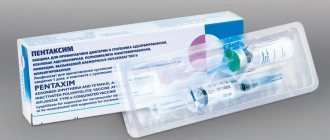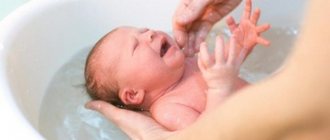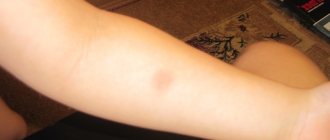WHY DO YOU NEED DIASKIN?
Many people confuse Diaskintest with a vaccine. But this is not true at all. There is no point in refusing the test, since up to 95% of adults today are infected with Koch's bacillus. That is, they are carriers of tuberculosis bacteria. This carriage is called the latent form of the disease - when a person is not sick, but the disease can develop under certain conditions. This option is observed in 1% of patients. Moreover, the infectious process can be asymptomatic for a long time. Without testing, it is impossible to identify it only by external signs. And the earlier the tuberculosis process is detected, the higher the patient’s chances of recovery.
Contraindications for Diaskintest
Despite the safety of the vaccine composition used to test for tuberculosis, we should not forget that Diaskintest is, first of all, an allergen. Therefore, it is strictly contraindicated for dermatological problems, people with hypersensitivity, and patients with epilepsy.
The vaccine should not be administered if the patient has infectious diseases that occur in acute or chronic form. Injection is prohibited for persons with hepatitis or inflammatory processes of the respiratory system.
Relative contraindications not listed in the instructions include women during pregnancy and lactation, in the presence of somatic pathologies, and during quarantine. It is prohibited to carry out Diaskintest if a Mantoux or BCG test has previously been done.
The procedure will not cause a tuberculosis infection, but the results will be incorrect. At least 1 month should pass between diagnostic measures.
FREQUENCY OF SAMPLE PERFORMANCE
According to the recommendation of the Russian Ministry of Health, Diaskintest must be performed once a year at the age of 8-17 years. When deciding how often you can test, take into account some nuances:
- The test can be done no earlier than a month after any vaccination.
- A month must pass after recovery from any infectious disease.
- If the previous test result was negative, the next test can be done after 2 months.
A control test for people registered at an anti-tuberculosis dispensary is carried out every 3-6 months.
If a child has a positive Mantoux test, he can perform Diaskintest from the age of 1 year.
What not to eat during Diaskintest
It is not necessary to change the child’s diet after the procedure. The daily diet should include all the usual foods, with the exception of those that can cause allergies. Before checking the Diaskintest results, you should not eat spicy or smoked foods that are not included in the child’s usual menu.
Results are checked 72 hours after the test.
At this time, you can eat sweets and other foods, but in moderation. If a child has diathesis or allergies, eating sweets in large quantities after the test is not recommended. Also, after vaccination, you should not eat any foods that were not previously included in the child’s diet.
It is necessary to limit the consumption of exotic fruits, honey, chocolate, citrus fruits and nuts. They can provoke an undesirable reaction in the child’s body. Sometimes the patient may be prescribed a special diet if the child has food allergies.
What can you eat
For healthy children there are no dietary restrictions. You can eat ready-made meals and products that are included in the child’s standard menu. The basis of a balanced diet should be seasonal vegetables and fruits, meat and dairy products, and fish.
Alcohol is not prohibited. Alcohol-based medications are allowed. However, it should be noted that drinking alcohol may cause cross-reactions.
COMPOSITION OF THE PREPARATION
The drug contains:
- Proteins of tuberculosis bacteria CFP10 ESAT6, prepared in a special way.
- Phenol as a preservative.
- Polysorbate as a stabilizer.
- Phosphoric acid sodium, potassium.
- Sodium chloride.
- Water.
Diaskintest is a Russian drug. You can get tested at various institutions. Most often, the test is performed in kindergartens, schools, clinics, or in anti-tuberculosis institutes, centers, and dispensaries. For adults, examination is prescribed if there is contact with patients or in cases where a person is registered at a dispensary.
HOW RESULTS ARE EVALUATED
The reaction is checked 3-4 days after the test. The result can be positive, negative or false positive (doubtful). A negative result is the norm for children and adults. If there is no reaction at all, there should be no papules or redness.
The first reaction can be observed 6 hours after administration of the drug. The test result is the response of a person’s immune system. Inflammation and redness may be observed on the first day after testing. The response may increase over 72 hours, with maximum results observed on the third day in adults and children. Then the reaction fades away.
When can you do a test, after how long?
It is recommended to use the medicine after the alcohol has been completely processed in the body, that is, with a body weight of 60 kg, it takes about 6 hours for 100 grams of vodka to be eliminated from the body.
To quickly remove alcohol from the body, you can resort to the following actions:
- Drinking plenty of fluids, which speeds up metabolism and removes all waste products from the body.
- Drink strong tea with sugar.
- Brew herbal teas as a drink.
- Consume large amounts of sugar in the form of fruit or large amounts of protein from meat or fish products.
- Engage in simple sports or mental exercises.
So, if you conduct a test before alcohol is removed from a person’s internal organs, there is a risk of complications; the general recommended period is 24 hours after consumption.
Only after a doctor’s prescription and recommendation should you start taking a test for tuberculosis.
↑
POSITIVE RESULT
The presence of a papule of any size indicates that the patient is infected with tuberculosis bacteria. In adults, the size of the inflammatory papule is not critical. However, for ease of assessment, a general classification of swelling sizes is used:
- Less than 5 mm – weak.
- No more than 9 mm – moderate.
- Over 10 mm – strong.
The more pronounced the reaction, the more pathogen is present in the human body. The patient must go to the dispensary for treatment and registration.
In children, the presence of a papule also requires immediate consultation with a doctor. Additional studies will be needed to assess the form of the disease - active or latent. Special treatment is also used.
When can you take the drug if you have been drinking alcohol?
If you first consumed alcohol, you need to wait 16 hours before testing. The test for tuberculosis must be done in full accordance with the recommendations of doctors.
You also need to take into account that you will need an examination and consultation with a doctor who, based on the characteristics of the body, can tell you exactly how to do a test for tuberculosis.
The alcohol breakdown product will negatively affect the tuberculosis test, which may result in incorrect results. Alcoholism has no effect on the quality of the test, and also does not cause unpleasant consequences for the body.
Any drug has a negative effect on a person, so ideally it is better to abstain from alcohol so as not to aggravate the patient’s condition.
SIDE EFFECTS, COMPLICATIONS
Diaskintest is harmless for patients of any age, so there is no fear of a reaction in children and adults. Any side effects can be observed only in rare cases in the form of symptoms indicating general intoxication. These include headache and weakness, general malaise, and increased temperature. This is a normal reaction. Small bruises at the injection site are also not a cause for concern.
A hyperergic reaction of the body to the administration of the drug may also occur - the formation of a large papule with a diameter of more than 15 mm. The same reaction includes severe inflammation and irritation of the tissue around the papule.
The test is carried out every Saturday.Diaskintest is an express method for diagnosing tuberculosis. Diaskintest involves injecting a small amount of a special solution into the skin of the person being examined, which contains proteins characteristic only of tuberculosis pathogens.
Diaskintest gives a positive result only in the case of people infected with tuberculosis, as well as in persons with tuberculosis. Diaskintest gives a negative result in persons who are not infected and do not have tuberculosis, as well as after complete recovery from tuberculosis. Diaskintest results also remain negative if a person has immunity after vaccination against tuberculosis (BCG) or if the person being tested is infected with mycobacteria that cannot cause tuberculosis (false positive results of the Mantoux test). Diaskintest is a much more specific and effective method for diagnosing tuberculosis than the Mantoux test. What is Diaskintest? Diaskintest is a new method for diagnosing tuberculosis and tuberculosis conditions, which is based on determining the reaction of the body of the person being examined to special substances that are found only in microbes that cause tuberculosis. Diaskintest was developed at the Russian Research Institute of the Moscow Medical Academy named after. THEM. Sechenov and has currently undergone clinical studies that have shown its high effectiveness.
What are the advantages of Diaskintest compared to the Mantoux test? The currently existing intradermal methods for diagnosing tuberculosis (Mantoux test and Diaskintest) work on the same principle: a small amount of a special solution containing substances that are found in the structure of tuberculosis pathogens is injected into the patient’s skin (most often on the forearm). The solution for performing the Mantoux test contains tuberculin - a special protein that is found in the causative agents of tuberculosis, as well as in their “close relatives” bacteria, which are used in the BCG vaccination and in non-pathogenic mycobacteria, which are very similar to the causative agents of tuberculosis, but, unlike the latter, cannot provoke illness in humans. The solution for Diaskintest contains only synthetic proteins ESAT6/CFP10, characteristic exclusively of tuberculosis pathogens. Due to the different composition, the results of Diaskintest and the Mantoux test reveal two different aspects of the state of anti-tuberculosis immunity: a positive result of the Mantoux test means that the body of the person being examined is familiar with tuberculin, which in turn may mean that the person being examined has either been in contact with a tuberculosis infection or has recently received BCG vaccination, or infected with non-pathogenic mycobacteria, which cannot cause disease and therefore do not require any treatment. The last two types of Mantoux test results are called false positive. Unlike the Mantoux test, Diaskintest gives a positive result only if the body of the person being examined is familiar with proteins that can only be found in tuberculosis pathogens. In other words, a positive Diaskintest result indicates with a high degree of accuracy that the person being examined is either currently infected with tuberculosis or is already suffering from it. Thus, Diaskintest, in comparison with the Mantoux test: allows you to get an accurate result and distinguish the state of tuberculosis infection from false positive reactions in people vaccinated with BCG and people infected with non-pathogenic mycobacteria; it has high sensitivity: all patients infected with tuberculosis and tuberculosis-infected people who may get tuberculosis in the near future time they give a positive reaction to Diaskintest makes it possible to judge the effectiveness of tuberculosis treatment: all people who recovered from tuberculosis have a negative Diaskintest result
Positive Mantoux reaction - what to do? If you receive a positive Mantoux test reaction (see Mantoux test - reading the results), it is necessary to find an opportunity to conduct a repeat examination using Diaskintest in order to exclude false-positive Mantoux results and avoid the need for preventive treatment. Technique for performing Diaskintest Injection of the drug for Diaskintest is carried out in exactly the same way as for the Mantoux test: strictly intradermally, in the area of the middle third of the forearm, with a thin needle. Often, Diaskintest and the Mantoux test are performed simultaneously (on different hands), which makes it possible to identify false positive Mantoux reactions.
How are Diaskintest results read? Diaskintest results are read 72 hours after the injection. The doctor evaluates the diameter of the red spot (hyperemia) and compaction (papules) that have formed at the injection site. Diaskintest results can be negative - if there is no red spot or lump at the injection site, doubtful - if there is only a red spot or a small swelling with a diameter of less than 2-4 mm at the injection site, positive - if there is a swelling with a diameter of 5 mm or more at the injection site; hyperergic: when a compaction with a diameter of more than 15 mm or more forms at the injection site, as well as in the case of the appearance of vesicles, ulcerations or enlarged lymph nodes in the antecubital fossa or in the armpit at the injection site. All persons who have had a questionable, positive or hyperergic reaction to Diaskintest require additional examination for tuberculosis.
In what cases should Diaskintest not be performed? Diaskintest cannot be performed in the case of acute and chronic infectious diseases occurring with an increase in temperature: ARVI, pyelonephritis, pneumonia, bronchitis, etc. exacerbation of diseases of internal organs (hepatitis, colitis, pancreatitis, pyelonephritis, etc.) the presence of skin diseases in the acute phase (atopic dermatitis ) recent exacerbation of allergies in patients with epilepsy (especially in cases of poor seizure control)
Can Diaskintest provoke tuberculosis? Preparations for Diaskintest are obtained from genetically modified strains of Escherichia coli, which in no case can cause the development of tuberculosis. Diaskintest is usually very well tolerated, only in rare cases there is a short-term and slight increase in temperature, mild headache and malaise.
Diaskintest and vaccinations The interval between Diaskintest and preventive vaccinations (including BCG) should be at least 1 month.
BEHAVIOR AFTER THE TEST
After placing Diaskintest, you can wet your hand, take a shower or bath. It is strictly not recommended to scratch the injection site, cover this area with a plaster, or wrap it with a bandage. Also, do not lubricate the injection site with creams, detergents and other cosmetics. There are no dietary restrictions.
Diaskintest has high sensitivity - about 80%, and accuracy reaches almost 100%. But, like any medical test method, this sample can make mistakes.
Diaskintest is many times more accurate than Mantoux, since it does not show positive reactions in people with acquired anti-tuberculosis immunity. That is why this test is considered the most reliable and safe. With its help, you can find out whether the patient is sick at the moment, and analyze whether the person will get sick in 1-2 years.
Dietary recommendations for children
Parents should monitor the nutrition of children from birth; they are the ones who instill in the child the correct principles and eating habits. If mommy gives the baby a bag of chips instead of an apple, then why be surprised if, as he grows up, he doesn’t want to eat healthy cottage cheese, for example, or porridge.
During diaskintest, you can eat the food that the child is accustomed to, if specifically according to the recommendations, then you can give the following:
- The diet should be balanced and varied.
- Fresh fruits and vegetables should be on the table regularly, even more so in winter. But possible allergens should be given with caution.
- If the child is accustomed to sweets, then you should not completely exclude them, but it is better to give healthy ones, for example, marshmallows, marshmallows, marmalade. A great alternative to dried fruits.
- Do not introduce your child to carbonated drinks; it is better to buy juice or prepare it yourself from fresh fruit. Coca-Cola and Pepsi-Cola should be banned.
- Eliminate crackers and chips from your diet. These harmful products do not give anything but diseases of the gastrointestinal tract.
- A child should eat only healthy food; he should not be taught fast food or processed foods from childhood.
- From childhood, you need to accustom your baby to dairy products. A growing body needs calcium for the proper formation of the musculoskeletal system.

From childhood, a child learns from his family and from his parents what proper nutrition is. If it’s customary to sit in front of the TV in the evenings with a huge bag of chips, then what’s so surprising if your child then does the same.
There is no need to be afraid of undergoing a diaskintest; it will allow you to identify the disease at the very beginning of its development, which will certainly affect the success of treatment.

